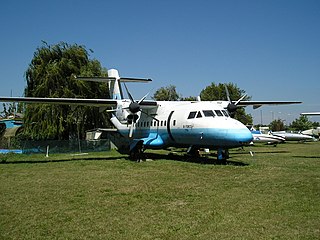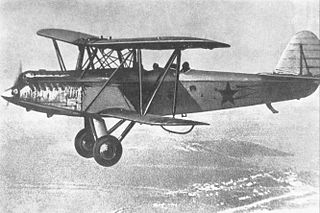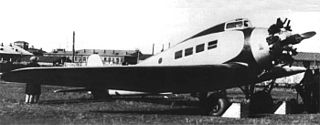
The Tupolev Tu-114 Rossiya is a retired large turboprop-powered long-range airliner designed by the Tupolev design bureau and built in the Soviet Union from May 1955. The aircraft was the largest and fastest passenger plane at that time and also had the longest range, at 10,900 km (6,800 mi). It has held the official title of fastest propeller-driven aircraft since 1960.

The Tupolev Tu-134 is a twin-engined, narrow-body jet airliner built in the Soviet Union for short and medium-haul routes from 1966 to 1989. The original version featured a glazed-nose design and, like certain other Russian airliners, it can operate from unpaved airfields.

The Tupolev Tu-104 is a retired medium-range, narrow-body, twin turbojet-powered Soviet airliner. It was the second to enter regular service, behind the British de Havilland Comet and was the only jetliner operating in the world from 1956 to 1958, when the British jetliner was grounded due to safety concerns.

The Tupolev Tu-124 is a 56-passenger short-range twinjet airliner built in the Soviet Union. It was the first Soviet airliner powered by turbofan engines.

The Antonov An-10 Ukraina is a four-engined turboprop passenger transport aircraft designed in the Soviet Union.

The Tupolev ANT-20 Maxim Gorky was a Soviet eight-engine aircraft, the largest in the world during the 1930s. Its wingspan was similar to that of a modern Boeing 747, and was not exceeded until the 64.6-metre (212 ft) wingspan Douglas XB-19 heavy bomber prototype first flew in 1941.
The Tupolev ANT-7, known by the VVS as the Tupolev R-6, was a reconnaissance aircraft and escort fighter of the Soviet Union. The R-6 traces its roots back to early 1928 when the Soviet Air Force needed a long-range multirole aircraft. The requirements were that it could be used for long-range transport, defensive patrolling, reconnaissance, light bombing and torpedo attack.

The Tupolev TB-1 was a Soviet bomber aircraft, an angular monoplane that served as the backbone of the Soviet bomber force for many years, and was the first large all-metal aircraft built in the Soviet Union.

The Tupolev TB-3, OKB designation ANT-6, was a monoplane heavy bomber deployed by the Soviet Air Force in the 1930s and used during the early years of World War II. It was one of the world's first cantilever wing four-engine heavy bomber. Despite obsolescence and being officially withdrawn from service in 1939, the TB-3 performed bomber and transport duties throughout much of World War II. The TB-3 also saw combat as a Zveno project fighter mothership and as a light tank transport.

The Beriev Be-30 is a Russian regional airliner and utility transport aircraft designed by the Beriev Design Bureau. It was developed specifically for Aeroflot local service routes using short, grass airstrips. It was also designed to be used in the light transport, aerial survey and air ambulance roles. It competed against the Antonov An-28 and the Czechoslovakian LET-410.

The Let L-610 is a prototype aircraft for the Czech civil aircraft manufacturer Let Kunovice made in 1988–1997.

The Beriev MBR-2 was a Soviet multi-purpose flying boat which entered service with the Soviet Navy in 1935. Out of 1,365 built, nine were used by foreign countries. In the Soviet Union, it sometimes carried the nickname of "Kорова" (cow) and "Амбар" (barn).
The Tupolev ANT-9 was a Soviet passenger aircraft of the 1930s. It was developed as a reaction to the demand for a domestic airliner. At this time Deruluft, one of the forerunners of Aeroflot, flew only with foreign models, which were mainly German or Dutch.

The Polikarpov R-5 was a Soviet reconnaissance bomber aircraft of the 1930s. It was the standard light bomber and reconnaissance aircraft of the Soviet Air Force for much of the 1930s, while also being used heavily as a civilian light transport, some 7,000 being built in total.

The Heinkel HD 37 was a fighter aircraft, designed in Germany in the late 1920s, but produced in the USSR for Soviet Air Force service. It was a compact, single-bay biplane with staggered wings of unequal span, braced by N-type interplane struts. The pilot sat in an open cockpit, and the main units of the tailskid undercarriage were linked by a cross-axle.

The Kalinin K-4 was an airliner built in the Soviet Union in the late 1920s which was also adapted for use as a photographic survey aircraft and as an air ambulance. A further development of the K-1, it was a conventional high-wing, strut-braced monoplane with separate enclosed cabin and cockpit. Kalinin undertook the design to offer a locally produced alternative to pioneering Ukrainian airline Ukrvozdukhput, which was at that time flying Dornier designs. The structure was of mixed wood and metal construction, but with major assemblies designed in both wood and metal versions, allowing them to be interchanged. The design also featured a variable-incidence horizontal stabiliser, and the engine mounting was intended to facilitate the ready interchange of different powerplants.

The Kharkiv KhAI-1 (ХАІ-1) was an airliner produced in the Soviet Union in the early 1930s, unusual in that it was designed by students. An exceptionally clean design, the KhAI-1 was the first European passenger transport aircraft to feature retractable undercarriage, and boasted a top speed better than the fighter aircraft in service at the time. Some 40 KhAI-1s were operated by Aeroflot, but while a dedicated military version, the KhAI-1VV was developed and flown in prototype form, this did not enter production.

The Kalinin K-7 was a heavy experimental aircraft designed and tested in the Soviet Union in the early 1930s. It was of unusual configuration, with twin booms and large underwing pods housing fixed landing gear and machine gun turrets. In the passenger version, seats were arranged inside the 2.3-meter thick wings. The airframe was welded from KhMA chrome-molybdenum steel. The original design called for six engines in the wing leading edge, but when the projected loaded weight was exceeded, two more engines were added to the trailing edges of the wing, one right and one left of the central passenger pod. Nemecek states in his book that at first only one further pusher engine was added.

The Tupolev ANT-35 was a 1930s Soviet twin-engined light transport monoplane that entered service with Aeroflot in 1937 as the Tupolev PS-35.

The Laville PS-89, also known as the ZIG-1, was an airliner produced in small numbers in the Soviet Union in the 1930s. Design work commenced in 1933 to provide Aeroflot with an airliner of contemporary design, to replace the obsolete Tupolev ANT-9s and Kalinin K-5s then in service. Designed by French engineer André Laville, it was a low-wing cantilever monoplane of conventional design, with twin engines in wing-mounted nacelles, and retractable tailwheel undercarriage. Construction was of metal throughout, except for the fabric skinning of the control surfaces. Laville left the project before the prototype was built, and A.V. Kulev replaced him to lead the project.


















